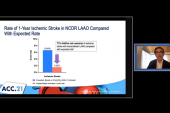Short-term LAA Occlusion Outcomes Worse in Women
Women had more pericardial effusions requiring drainage and more major bleeds than men, as well as longer hospital stays.

Women with atrial fibrillation (AF) undergoing left atrial appendage occlusion (LAAO) with the Watchman device (Boston Scientific) have poorer in-hospital outcomes compared with men, according to data from the LAAO Registry.
Specifically, women were more likely to have a major adverse event, including pericardial effusion requiring drainage and major bleeding, as well as a hospital stay lasting more than a day. Though the mortality rate was low overall, it was significantly higher in women (0.3% vs 0.1%; P < 0.001), report investigators.
“Unfortunately, I'm not surprised that women are at increased risk of adverse events undergoing LAAO, as it is in line with prior invasive procedures demonstrating disparate outcomes, such as TAVR, AF ablation, and [implantable cardioverter-defibrillator therapy],” lead author Douglas Darden, MD (University of California, San Diego), told TCTMD via email. “Although I did not expect such drastic differences in outcomes.”
A key question, he said, is what’s causing the disparities, and that remains unclear. “It is likely multifactorial,” Darden said. “It may be related to anatomical factors, such as a friable left atrial appendage or smaller vessel diameter. Or it may be related to other factors that are difficult to measure, such as implicit bias, late referral of women, or frailty.”
Speaking with TCTMD, senior author Jonathan Hsu, MD (University of California, San Diego), said a positive finding from the study, published online recently in JAMA Cardiology, is that women made up a large proportion of the patient population (41.3%). “It’s great to see that women are receiving procedure-based therapy,” he said.
Their poorer short-term outcomes, however, should be discussed by operators when counseling patients about LAAO and should “inform future studies in regards to how we can improve the care of women compared to men,” Hsu stressed.
LAAO Registry
As noted by Darden, prior studies have shown that women often fare worse than men for various invasive CV procedures, so he, Hsu, and colleagues set out to examine the issue in the setting of LAAO, for which such sex-specific data are limited.
They analyzed data from the LAAO Registry, part of the National Cardiovascular Data Registry (NCDR), on 49,357 patients (mean age 76.1 years) treated with the Watchman device between January 2016 and June 2019 at 597 hospitals across the United States. Women were slightly older on average; had a higher mean CHA2DS2-VASc score (5.3 vs 4.5); were more likely to have paroxysmal AF, prior stroke, and uncontrolled hypertension; and were less likely to have congestive heart failure, diabetes, and CAD.
On multivariate adjustment, women were not more likely than men to have aborted or canceled procedures (3.0% vs 2.9%; OR 1.01; 95% CI 0.90-1.13) but were more likely to experience other adverse outcomes, including any adverse event (6.3% vs 3.9%; OR 1.63; 95% CI 1.49-1.77) and any major adverse event (4.1% vs 2.0%; OR 2.06; 95% CI 1.82-2.34). The latter difference was driven by more pericardial effusions requiring drainage (1.2% vs 0.5%) and major bleeds (1.7% vs 0.8%).
The proportion of patients with a hospital stay longer than 1 day was higher in women (16.0% vs 11.6%; OR 1.46; 95% CI 1.38-1.54), as was the in-hospital mortality rate (0.3% vs 0.1%; OR 2.01; 95% CI 1.31-3.09).
Hsu believes the difference in outcomes is real considering the extensive statistical adjustment used in the study. It’s also consistent with prior research showing that women have a higher risk of perforation during certain electrophysiology procedures. The current study cannot address that possibility directly, he said, “but one does wonder if that could account for some of the differences seen in women versus men in regards to some of the complications.”
The investigators also found sex differences in use of antithrombotic therapy. A combination of anticoagulant and single antiplatelet therapy was the most common regimen overall, but it was used slightly less frequently in women (62.1% and 65.6%; OR 0.91; 95% CI 0.87-0.95). Women were more likely to receive direct oral anticoagulants alone (16.5% vs 9.6%; OR 1.07; 95% CI 1.01-1.13) and warfarin alone (13.5% vs 7.9%; OR 1.12; 95% CI 1.05-1.19).
Ameliorating Disparities
Although the study was not designed to explore mechanisms underlying the elevated short-term risks in women versus men, there are “several plausible explanations,” the authors note.
Anatomical differences are one, and women in this study had a smaller LAA maximal width. “However, other characteristics, such as left atrial size, LAA morphology, and number of device deployment attempts, may have important risk implications with regard to pericardial effusion that are not captured in the registry,” the investigators point out.
“Moreover, clinician inexperience may be associated with the risk of adverse events, particularly if those clinicians are more likely to perform LAAO for women who may be inherently at increased risk owing to anatomical issues or underlying comorbid conditions,” they suggest.
In addition, it’s possible that women are frailer or receive less-aggressive antithrombotic therapy than men, although that requires confirmation in future studies, they say.
“Although we cannot fully elucidate the causes of the increased risk of adverse events experienced by women, several strategies may mitigate procedural risk, including ultrasonography-guided venous access, preprocedural imaging to evaluate cardiac function, LAA size and morphology to guide equipment and device selection, developing proficiency with LAAO devices, and continued development of safer devices,” the researchers state.
They stress the importance of getting more women into clinical trials, as well, because that will “better inform clinical decision-making and adequately delineate sex-based safety and efficacy outcomes.”
And beyond that, Darden said, “we should devote further studies to studying anatomical differences between men and women.”
Todd Neale is the Associate News Editor for TCTMD and a Senior Medical Journalist. He got his start in journalism at …
Read Full BioSources
Darden D, Duong T, Du C, et al. Sex differences in procedural outcomes among patients undergoing left atrial appendage occlusion: insights from the NCDR LAAO registry. JAMA Cardiol. 2021;Epub ahead of print.
Disclosures
- This research was supported by the American College of Cardiology Foundation’s NCDR.
- Hsu reports personal fees from Abbott, AltaThera, Biosense Webster, Biotronik, Boston Scientific, Bristol-Myers Squibb, Janssen, Medtronic, Pfizer, and Zoll Medical; grants from Biosense Webster and Biotronik; and equity interest in Acutus Medical and Vektor Medical outside the submitted work.
- Darden reports no relevant conflicts of interest.





Comments